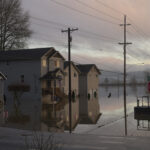New research by U.S. Geological Survey scientists is casting doubt on the long-held idea that the New Madrid fault zone in Missouri’s Bootheel unleashed a series of devastating earthquakes in 1811 and 1812.
In a new study, the researchers say the Wabash Valley Fault line that runs through southern Illinois may have been responsible, and that immediate and intense study of the fault’s quake potential is needed.
“What is puzzling is that when we measure the long-term rate of motion along the New Madrid Fault, it’s almost zero,” said Douglas Wiens, a professor and of earth and planetary sciences at Washington University in St. Louis. “How to interpret that is a big discussion among scientists. Some even suggest the recent quakes along the New Madrid Fault Zone are nothing more than aftershocks of the 1811-1812 events.”
Scientists note that there hasn’t been a magnitude 6.0 earthquake on the New Madrid Fault in more than a century, the Evansville Courier & Press reports. But in the last 20 years, there have been at least three magnitude 5.0 or greater tremors along the Wabash Valley Fault, including a magnitude 5.2 quake in 2008 that was felt as far away as Milwaukee, Des Moines, Iowa and Atlanta.
Susan Hough, a U.S. Geological Survey scientist in Pasadena, Calif., and five other researchers suggest in the publication “Seismological Research Letters,” that the Jan. 23, 1812, earthquake may have occurred in White County, Ill.
The White County site is along the Wabash Valley Fault, 130 miles from the New Madrid Seismic Zone.
The researchers base their hypothesis on evidence of liquefaction at farms in the area and a written account from a White County man who witnessed the 1812 quake.
Yearby Land wrote: “A big crack was made in the ground and you could not see to the bottom of it. The ground on the south of the crack sunk down about two feet. There were many square miles of level plain, and over it, in the earthquake times, piles of pure, snow white sand were heaved up.”
A 10-year study to map the structure of North America will include a thorough study of the Wabash Valley Fault system within the next two years. EarthScope, a joint effort of NASA, the National Science Foundation and the U.S. Geological Survey, has scientists deploying transportable broadband seismic stations on a grid across the United States.
“In the 1970s, a network of seismographs were put in around the New Madrid Fault,” Wiens said. “There’s really not that many instruments recording activity along the Wabash Valley Fault. That will all change when a large array of seismic experiments is conducted in 2012.”
A series of four earthquakes in 1811 and 1812 were among the most violent earthquakes to ever hit the U.S. The quakes were estimated at magnitude 7.5 to 8.0, so strong the Mississippi River reportedly flowed backward. Damage occurred as far away as Washington, D.C., and Charleston, S.C.
Was this article valuable?
Here are more articles you may enjoy.

 LA Fires Push Insurers’ 2025 Disaster Losses to $107 Billion
LA Fires Push Insurers’ 2025 Disaster Losses to $107 Billion  Asahi Sales Drop Worsens as Cyber Hack Disruption Lingers
Asahi Sales Drop Worsens as Cyber Hack Disruption Lingers  Pacific Northwest Braces for Even More Flooding Rain This Week
Pacific Northwest Braces for Even More Flooding Rain This Week  Atmospheric River to Flood Pacific Northwest Through Week
Atmospheric River to Flood Pacific Northwest Through Week 